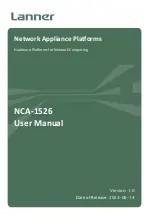
302
Value Description
G
The digest from the exclusive-or (XOR) operation between the 32-bit segments of the IPv6
multicast group address. For example, if the IPv6 multicast address is
FF0E:C20:1A3:63::101, G = 0xFF0E0C20 XOR 0x01A30063 XOR 0x00000000
XOR 0x00000101.
M
Hash mask length.
C
i
The digest from the exclusive-or (XOR) operation between the 32-bit segments of the C-RP
IPv6 address. For example, if the IPv6 address of the C-RP is 3FFE:B00:C18:1::10, C
i
=
0x3FFE0B00 XOR 0x0C180001 XOR 0x00000000 XOR 0x00000010.
&
Logical operator of "and."
XOR
Logical operator of "exclusive-or."
mod
Modulo operator, which gives the remainder of an integer division.
Embedded RP
The embedded RP mechanism enables a router to resolve the RP address from an IPv6 multicast address
so that the IPv6 multicast group is mapped to an RP. This RP can take the place of the statically configured
RP or the RP dynamically calculated based on the BSR mechanism. The DR does not need to learn the RP
address beforehand. The specific process is as follows:
•
At the receiver side:
a.
A receiver host initiates an MLD report to announce that it is joining an IPv6 multicast group.
b.
After receiving the MLD report, the receiver-side DR resolves the RP address embedded in the
IPv6 multicast address and sends a join message to the RP.
•
At the IPv6 multicast source side:
c.
The IPv6 multicast source sends IPv6 multicast traffic to the IPv6 multicast group.
d.
The source-side DR resolves the RP address embedded in the IPv6 multicast address, and sends
a register message to the RP.
RPT building
Figure 86
RPT building in an IPv6 PIM-SM domain
Source
Server
Host A
Host B
Host C
Receiver
Receiver
IPv6 multicast packets
RPT
Join message
RP
DR
DR
















































